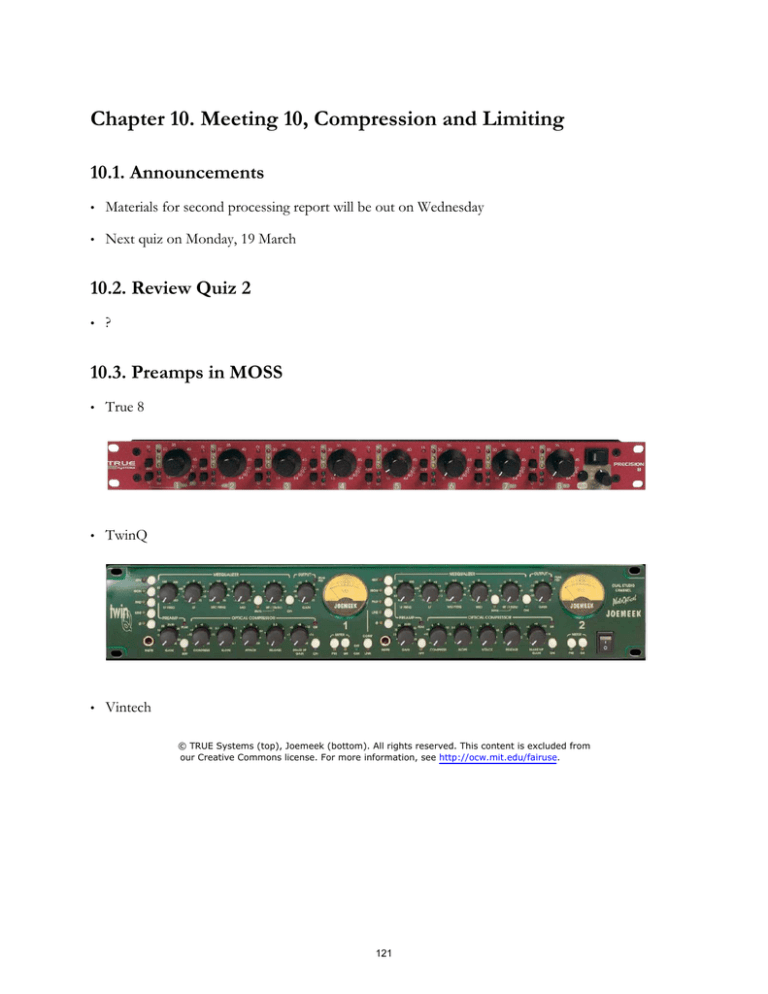
Chapter 10. Meeting 10, Compression and Limiting
10.1. Announcements
•
Materials for second processing report will be out on Wednesday
•
Next quiz on Monday, 19 March
10.2. Review Quiz 2
•
?
10.3. Preamps in MOSS
•
True 8
•
TwinQ
•
Vintech
© TRUE Systems (top), Joemeek (bottom). All rights reserved. This content is excluded from
our Creative Commons license. For more information, see http://ocw.mit.edu/fairuse.
121
•
JDK R20
© Vintech Audio (top), JDK Audio (bottom). All rights reserved. This content is excluded from
our Creative Commons license. For more information, see http://ocw.mit.edu/fairuse.
10.4. Dynamics: Background
•
Amplitude is not the same as perceived loudness
•
Perceived loudness has more to do with average signal level (RMS)
•
Our ears are more sensitive to amplitudes in certain frequency ranges
•
Transients (the attack of instruments) cary essential sonic information
10.5. Dynamics Processors: Terms
•
Threshold: a point of amplitude reference within the dynamic range
•
Ratio: used to transform amplitudes by converting input values into output values
•
2:1 means for every 2 dB in over the threshold, 1 dB comes out
•
6:1 means for every 6 dB in over the threshold, 1 dB comes out
•
Attack: how quickly processing start on onset of amplitude above threshold
•
Release: how quickly processing stops on onset of amplitude below threshold
122
10.6. Dynamics Processors: Input-Output Transformation
Output dB
Graph input amplitude to output amplitudes via transfer curve
Output dB
•
Input dB
Input dB
Image by MIT OpenCourseWare.
•
A ratio of 1:1 is no change, or bypass
•
A shifting the 45 degree line up or down is a boost or cut in amplitude
10.7. Dynamics Processors: Two Basic Families
•
Processors that reduce amplitudes when amplitudes are above a threshold (downward
compression and limiting)
•
Processors that reduce amplitudes when amplitudes are below a threshold (downward expansion
and gating)
•
While amplitudes are reduced, this does not mean that dynamic effects only make sounds more
quiet
10.8. Gain Reduction Above a Threshold: Compressor
•
Reduces (compresses) dynamic range and increases average signal level
•
Handles situations where a track needs to be turned up but cannot be turned up without clipping
•
Often used to reduce the amplitude volatility of a signal: vocals
•
Can raise level of quiet signals: can increase sustain, background, and ambience
•
Can increase leakage and noise floor
123
10.9. Compression: Two Steps
•
•
Two steps
•
1. Reduce gain above a threshold with a ratio
•
2. Increase gain of the modified signal
Steps
124
To be compressed
Sound Energy
Uncompressed Peak
Threshold
Time
Compression occurs
Sound Energy
Previous 0 VU
Threshold
Time
Sound Energy
0 VU
Boost overall level
Time
Image by MIT OpenCourseWare.
125
10.10. Compression: Ratio
•
Ratio
Image removed due to copyright restrictions.
"Compression with a 3:1 Ratio" from Gibson, B.
Microphones & Mixers. Hal Leonard Corp., 2007.
10.11. Compression: Knees
•
Hard and soft knee
126
Image removed due to copyright restrictions.
"Hard Knee vs. Soft Knee Compression/Limiting" from Gibson, B.
Microphones & Mixers. Hal Leonard Corp., 2007.
10.12. Compression: Attack and Release
•
Attack and release
127
Image removed due to copyright restrictions.
"Using the Attack Time Setting to Control Understandability and Punch"
from Gibson, B. Microphones & Mixers. Hal Leonard Corp., 2007.
128
Effects of Compressor Attack and Release
Low ratio, slow attack time,
slow release time
Higher ratio, faster attack,
very fast release
Image by MIT OpenCourseWare.
•
Attack times generally around 20-50 ms
•
Release times generally around 100-300 ms
•
Slower attack times are critical for letting transients pass unaffected: this is often desirable
•
Fast attack times can result in lifeless and unnatural percussion sounds
•
Slower release times continue to reduce gain of sustain of instruments
•
Pumping: attack and release are too fast and compression is audible; sustain of a signal fades in
and out after attack of louder signals
•
Breathing: hearing the noise floor slowly rise after the signal falls below threshold; remove by
decreasing release time
10.13. Gain Reduction Above a Threshold: Limiter
•
A compressor taken to an extreme ratio
•
Ratios are in the range of 10:1 to infinity:1
•
Flattens the top of amplitudes (generally) without distortion (depending on attack)
•
Often used to protect equipment and limit dynamic ranges
10.14. Limiting: Example
•
Example
129
Image removed due to copyright restrictions.
"Limiting" from Gibson, B.
Microphones & Mixers. Hal Leonard Corp., 2007.
10.15. Reading: Katz: How to Manipulate Dynamic Range for Fun and
Profit
•
What does Katz say should be the paradigm of sound quality? Why is this often not possible?
•
Why was “popcorn noise” necessary for mastering audio for movies?
•
According to Katz, what affect does hard-knee compression have?
•
Why does Katz state that, in regard to attack and release times, its “probably better to remove all
the labels on the knob (except slow and fast) and just listen!" ”
130
•
How is lookahead implemented in digital compressor?
•
What is a brick-wall limiter?
•
How does Katz describe the release characteristics of an opto-compressor?
•
What is soft clipping, as found as a feature on some digital processors?
131
MIT OpenCourseWare
http://ocw.mit.edu
21M.380 Music and Technology: Recording Techniques and Audio Production
Spring 2012
For information about citing these materials or our Terms of Use, visit: http://ocw.mit.edu/terms.




